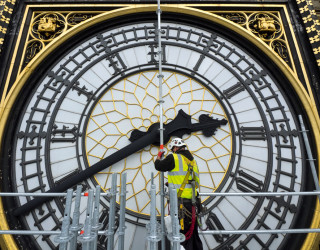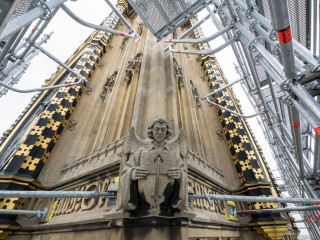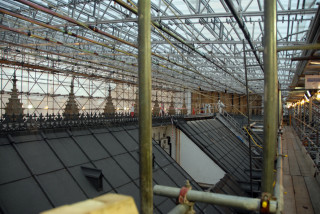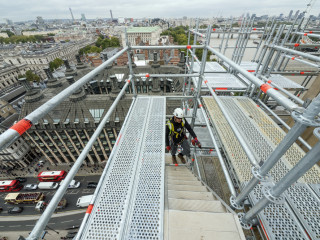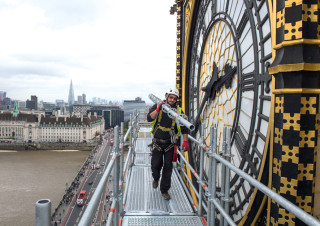Innumerable column-inches have been devoted to the proposed repair and restoration – at a cost of £3.5bn – of Victorian architect Sir Charles Barry’s famous Palace of Westminster, but work has been going on in various parts of the huge, rambling building for several years already.
Work is currently ongoing to repair the palace’s cast-iron-framed roof which has been leaking for years and is now badly corroded. This, and the separate contract to restore the iconic Elizabeth Tower, housing the Great Bell (better known as Big Ben) are examples of the current ‘patch-and-mend’ approach that tackles only the highest-risk problems.
In 2016, Parliament decided that after decades of under-investment this approach was no longer sustainable and a complete restoration project was required. The result was the launch of the Palace of Westminster Restoration and Renewal Programme, which is scheduled to start in a few years’ time and continue for at least six years after that.
Earlier this year, MPs voted by a narrow majority to vacate the building, when work starts in the mid-2020s, to make way for the construction teams. Had they decided not to move out, the project would probably drag on for more than 30 years and cost around £6bn rather than the current estimate of £3.5bn.
Meanwhile, work is afoot to repair the most famous part of the Palace, the Elizabeth Tower. The work will involve repairs to cracked and crumbling masonry, the repair of leaks and corroded metalwork and an overhaul of the clock itself. The tower also needs to be brought into line with current fire regulations and a lift will be installed to improve access.
The last major overhaul of the Elizabeth Tower was carried out in the mid-1980s and the last time it was scaffolded was in 1996 for work to stabilise the structure during the construction of the Jubilee Line extension.
Sir Robert McAlpine Special Projects (SRM) was awarded the contract for the current works in November 2016 and enlisted Uxbridge-based PHD Modular Access to erect a full scaffolding enclosure that envelops the Elizabeth Tower beneath a temporary roof.
The roof is erected over the top of the Ayrton Light, 100m above ground. The Ayrton Light is a lantern located inside the very top of the Elizabeth Tower and named after Liberal MP Acton Smee Ayrton who served as first commissioner of works between 1869 and 1873.
The lantern is switched on in the evening whenever Parliament is sitting. It was installed by Ayrton at the request of Queen Victoria so that she could see from Buckingham Palace when members of either House were sitting after dark.
PHD supplied a Layher system scaffold in preference to traditional tubes and fittings. Traditional scaffolding was quickly discounted as a possible solution due to the fact that the imposed leg loads of the design exceeded the capacity of conventional tubes and fittings. Another factor that had to be taken into account was the presence of the significant network of underground services that exists around the palace.
“This ultimately led to the decision to use a systemised scaffolding with higher structural capacity,” says PHD managing director Danny Dwyer. “While undertaking the design we further considered the risk of fire and therefore wanted to reduce the hazard associated with traditional timber or plastic decking. The Layher system uses only metal components which, by their nature, are fire-resistant.”
The scaffold is a substantial, complex assembly combining almost 24,000 individual components. Only 500 or so conventional scaffolding components have been used to date.
In fine British tradition the contractor has done some sums and discovered that if all the standards were laid end-to-end, they would stretch 9.5 miles, from Westminster to the Thames Barrier.
And if all the ledgers, transoms and bracing were added, the whole lot would extend for almost 20 miles to Potters Bar, north of the M25.

Meanwhile, the decking totals 19,864m2 which in layman’s terms is equivalent to nearly three average-sized football pitches.
The entire structure is bespoke, says PHD, and special arrangements were required to support it at ground level.
“We were limited by the grounding of the scaffold and could only use the east elevation, on Speaker’s Green. This meant providing foundations for the four gantry support towers with two steel gantries weighing 27 tonnes each,” explains Dwyer.
The modular scaffolding system is supported by the steelwork gantry, which was designed by SRM’s own in-house design group and detailed by Essex specialist Apex Steel Structures. The gantry was fabricated by two major steelwork producers located in Wales and the West Midlands. “Over 90% of the steel being used for the steel gantry [was] from British Steel,” Dwyer assures us.
Four years ago attention was focused on the tower’s four clock faces as maintenance workers abseiled down from the gallery above to clean the 312 panes of opal glass in each face. No abseiling is required for this contract, though, as the scaffold provides all necessary access to the tower.
“The bespoke nature of the restoration and the weights of the components being serviced ruled out the use of rope access or other lightweight solutions,” explains Dwyer. The Layher scaffolding is served by a high- capacity goods hoist and a passenger hoist to deliver people, materials and tools to the workface.
Nevertheless, the tower’s high cultural significance and iconic symbolism has meant a few unusual stipulations from the client. At least one of the clock faces must be visible at any time, so the scaffold is subject to periodic alterations.
And the client also specifically requested a low-density cladding for the scaffold so that the outline of the tower would remain visible and the public below would be able to watch the restoration works as they progress.
The tower – along with the rest of the palace – is a Grade I listed building which, of course, brings its own complications. “We are conscious of the risk of damage to the existing historical structure,” says Dwyer, “but the grounds around the tower also must be taken into consideration. There are protected trees nearby that cannot be touched.”
The unique experience of working on such a high-profile project is highlighted further by the extreme attention to detail demanded from the ground to the top of the tower. “The detail of the carvings, shields, finials, cast-iron work and the stonework in general is awe-inspiring especially considering it cannot be seen from ground level,” explains Dwyer.
It almost goes without saying that security is a major concern on this site – particularly in light of last year’s terrorist attack on Westminster Bridge and the ongoing ‘severe’ threat level set by MI5.
There were many factors to take into consideration during the planning and design phase of this contract, not least the need for security arrangements to accommodate trade and contractor requirements and a complex array of specialist requirements, loading capacities, multi-operational teams and stringent delivery protocols, says the contractor.
PHD’s personnel included four CITB apprentices and one of only 40 female scaffolders currently working in the UK.
The work is being carried out under an NEC 3 contract, which was awarded to SRM following a competitive OJEU tender process. Because of the stringent client requirements PHD was involved in the design process at a very early stage.
We have been engaged with the client team from the outset, allowing us to develop innovative design solutions to complex engineering challenges,” says Dwyer. “This would not have been feasible without the collaborative approach of Sir Robert McAlpine Special Projects.”
This article was first published in the March 2018 issue of The Construction Index magazine, which you can read for free at http://epublishing.theconstructionindex.co.uk/magazine/march2018/
UK readers can have their own copy of the magazine, in real paper, posted through their letterbox each month by taking out an annual subscription for just £50 a year. See www.theconstructionindex.co.uk/magazine for details.
Got a story? Email news@theconstructionindex.co.uk

